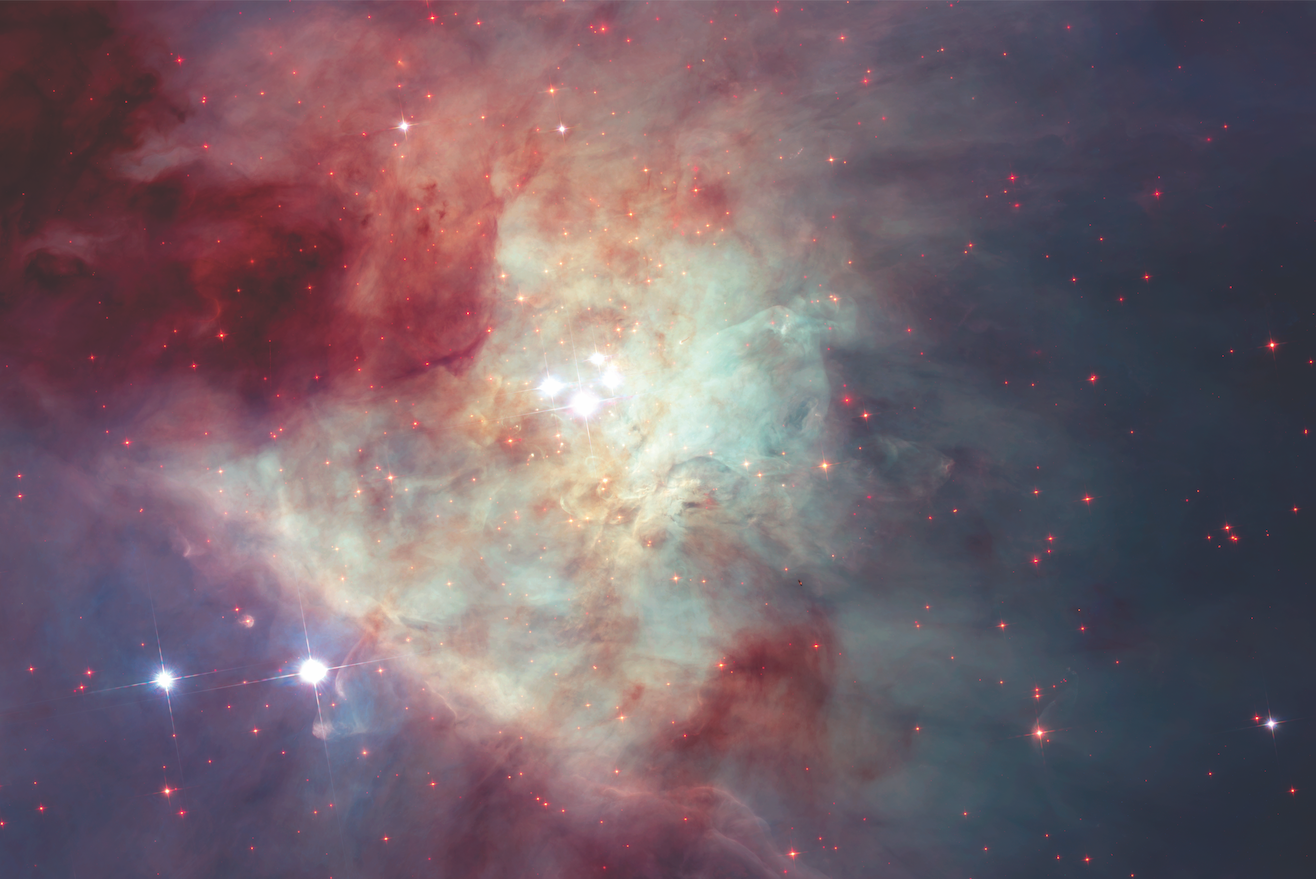
‘More questions than answers’
By Marlene Britton-Walfall
As a little girl growing up in Jamaica in the 1970s, I came across a song by Johnny Nash with a chorus that stayed with me: “There are more questions than answers,” he sang, “and the more I find out, the less I know.” This sentiment was certainly true for me at the time. I had so many questions then. I had questions about the stars, even as I determined that my favourite constellation was Orion. I had questions about how the Earth began and where the centre of the universe was. I had questions about whether teleportation was possible, and I wanted to try it — just like the characters on Star Trek.
Amid these questions, God was a certainty. No questions there. I had been taught that God was in charge of everything, and would take care of everything, and would reveal everything, in God’s time. And I believed that.
You may unsubscribe from any of our newsletters at any time.
I went on to answer some of my questions, as I chose geology as my field of study and delved into mountains of material that traced the genesis and development of the Earth and all its formations. This greater knowledge amplified my belief in a mysterious God who still offers so much more for us to discover.
Undoubtedly, humanity has made wonderful strides that have reaped untold benefits. We know how to put chemicals together to make life-saving drugs to treat diseases that were incurable mere decades ago. We know how to create new life in a lab, giving hope to people who are struggling to become parents. We know how to sustain people for weeks at a time in a space station suspended in orbit while they transmit valuable information back to Earth. We’ve been able to trace the origins of humanity, to follow and map eons of development through geological history and time.
And yet with all of this, we still don’t know so many things. Mystery surrounds the number of stars out there. The observable universe contains about 200 billion galaxies, an absolutely mind-blowing number — but new research from the Hubble Space Telescope suggests that there are 10 times more. What are the conditions on these other stars? Is there other life out there?
Closer to home, scientists are finding new questions about life here. A prehistoric jawbone unearthed in Israel showed that our ancestors may have left Africa far earlier than previously thought. This year, the oldest almost-complete human skeleton ever found in the United Kingdom revealed that the country’s earliest residents were actually dark-skinned. What are the implications of that? It would shake so many foundational principles!
Questions like these allow us to participate in the awesome mystery that is God. We have been able to explore, to use our scientific abilities to catch a glimpse of the magnificence that goes beyond what we can comprehend as humans.
And still, there are questions. Johnny Nash in his song continued, “What is life? How do we live? What should we take, and how much should we give?” These enduring questions guide the way we live in and with Creation. I will never be able to answer all the questions of life, but I am happy to know that science will continue to solve some. And maybe one day it might be possible for me to be teleported to another planet and experience another adventure. If that happens, I will be thankful to God. For wherever I am, God is, and all is well.
Marlene Britton-Walfall is a diaconal minister in Thunder Bay, Ont. She has a degree in marine science and geology.

‘Consider the lilies of the field’
By Libby Osgood
Staring up into the starry night sky, I am filled with an overwhelming sense of awe and wonder. Surely something so beautiful, so large and so grand, must have an initial mover, an unseen hand directing the motion. As the cosmos sings of mystery, scientists have revealed some of the secrets of the universe: they’ve sepa- rated the planets from the stars, defined the paths where these bodies travel and even predicted when infrequent guests such as Halley’s Comet come to visit. These discoveries give order to the pinpricks of light in the sky and illuminate the precision and attention to detail within such an enormous, grand design.
For hundreds of years, scientists believed the universe was static and unchanged. This understanding evolved in 1931 when Rev. Georges Lemaître hypothesized that the universe must actually have a beginning, a very dense point where everything initially existed. He called this the “single quantum,” which expanded to become everything in the universe in an event that is now referred to as the big bang. The timing of that initial expansion was crucial. If the expansion took even one millionth of one percent longer, the universe would have spread out too quickly, and all would have been dust. If the expansion was too slow, the universe would have drawn back together in a powerful implosion. Timing was everything.
For billions of years after the big bang, stars were born and stars died. Through this cycle of star life, molecules banged against each other and created more complex molecules, eventually creating the elements of the periodic table. In the last 4.5 billion years, the Earth developed and became home to single-celled organisms, sea creatures, land creatures, dinosaurs and ultimately humans. Considering how precise each of those steps had to be, how many small disruptions and mutations occurred to create a need to evolve, I marvel in the mystery of our improbable reality.
In nature, animals work together in symbiosis, relying on each other to survive. There are precise underwater locations near Hawaii that five-foot-long sea turtles swim to, then wait. The spot may look barren to us, but it’s actually a defined washing station. When a turtle arrives, dozens of fish appear and begin eating algae and parasites from the turtle’s shell. Without any acknowledgment, the turtle intuitively moves on when the cleaning is done, and the fish swim away. This cycle repeats as a new turtle appears.
In scripture, Jesus describes an intentional care for Creation when he says, “Look at the birds of the air. . . . Consider the lilies of the field.” God’s wonderful precision is evident too in each part of the lily. The curve of its petals can be described with an exact mathematical equation. The amount of energy its leaves chemically convert from light into food can be quantified. The amount of oxygen released, a mere byproduct, can be calculated. The fibrous material of its stem can be analyzed like a beam to determine the amount of force it uses to support its blossom, swaying in the wind. The precision of every aspect of the lily is intentional, evolved to exist on this planet as it is today, born from a single explosion 13.7 billion years ago.
How wonderfully mysterious is God, whose wisdom, love and energy, palpable scientifically and spiritually, produced the human, the turtle and its fish, the lily and the stars.
Sister Libby Osgood is an assistant professor in sustainable design engineering at the University of Prince Edward Island. She is on a leave of absence, preparing to become a religious sister with the Congregation of Notre Dame in White Plains, N.Y.

‘Things are not quite what they appear to be’
By Brian Goodings
Remember the days when you couldn’t quite recall the words to a song or the answer to questions like “When did the Leafs last win the Stanley Cup?” There really was no easy way of finding the answers quickly, but now they are just a click away thanks to Google and Siri. Our days are better for these electronic wizards, but it’s hard to get more than cheeky answers when we ask them big questions like “What is the meaning of life?”
People used to turn to their faith or to science for definitive answers to big questions. These knowledge systems promised us certainty, even though we have been proven incorrect on almost everything that has been predicted. We like to believe that the latest explanation is finally the right one — hence the oft-used phrase “We used to think X, but now we know Y.” It describes the shift from uncertainty to certainty. Like AlkaSeltzer, the shift brings welcome relief, at least for a while, and then something else in life proves too difficult to easily digest.
But we are generally not turning to science or to the churches of our ancestors for answers anymore, because so many explanations of the past have left us wanting. Our age might become known as the age of dawning uncertainty. The grand promise that absolutely everything can be discovered through logical scientific experimentation has been found to be just as unhelpful as theologies that make the claim that “everything in God’s plan happens for a reason.” We are pretty smart chimps and have been infatuated with our own intellectual prowess for a very long time. But the deeper we go in our quest for answers, the more complex the questions grow.
In 1927, German physicist Werner Heisenberg, one of the founders of quantum mechanics, introduced his uncertainty principle: one can know either a particle’s velocity or location — but not both at the same time. This was confounding for physicists who previously claimed that almost everything was measurable, quantifiable and behaved in a predictable manner. But in the world of atoms and electrons, things are not quite what they appear to be. Flux and change, not stability and certainty, are the rule. Weird stuff just happens.
For example, invisible relationships between some particles seem to be unbreakable no matter their distance from each other, a phenomenon called quantum entanglement. Taking action on one particle affects its partner, even when it’s far away. Einstein called it “spooky action at a distance” and is said not to have liked this physics very much at all.
Over the last 500 years or so, the scientific method promised a deeper understanding of reality than the church was offering, and we bought into it big time. Science looked like a pretty good alternative to faith, but quantum physics with all of its quirks and quarks and uncertainty has spoiled the illusion. Ironically, we used to think that science would bring us all the answers of life, but now we know it’s just another manner of considering the mysteries.
Deep faith and good science can certainly lead to illumination and answers about reality and our place within it, but we should never forget that curiosity, humility and uncertainty are really the state in which we dwell. It’s grand to ask and consider the big questions, but we really will only ever see all of the answers dimly in the mirror. I am very certain of that truth.
Rev. Brian Goodings is a minister at Trinity United in Collingwood, Ont. He has a degree in biology.

‘Beyond my wildest imaginings’
By Jeff Rock
Even though I am an ordained minister, I am still a scientist at heart. With that comes an inquiring mind that seeks to understand and to know even the unknowable. Whether designing experiments in my days as a student working in a neurobiochemistry lab or preparing for my latest sermon, the idea is the same — to seek out truth by asking questions and exploring the universe in which we live.
Before answering God’s call to serve in ministry, I started my post-secondary education in microbiology and immunology at McGill University in Montreal. I’m ashamed to admit that as a cradle United Churcher, who in first year lived in residence right next to a United church, I didn’t attend, not even once. Then, one Sunday morning in my second year, I awoke with a deep desire to be in Christian community. I found St. James United on Google, and I still remember the sermon.
The minister, Rev. Arlen Bonnar, said, “Look to your left; look to your right. . . . All of us reflect the diversity of God’s Creation. All of us are beloved children of God, made in God’s image.” And he was right: it was the most diverse collection of souls I’d ever seen assembled.
But how could that be? How could we all be made in God’s image, yet be so diverse? It was a paradox, this idea that we could be different, yet the same — a united body, with many different parts. Two seemingly contradictory statements can be held in tension and be equally true — that’s God’s divine mystery at work.
This idea of paradox has followed me throughout my professional life. For example, how can someone consider themselves a scientist, yet be a faith leader? Outsiders often assume there was some existential crisis that led me from science to religion, but on the contrary, the transition was natural. During those undergrad science days, I slowly became more interested in God talk and minored in religious studies. On my graduation day with my parents there to celebrate, I declared with trepidation that I wanted to be a minister. Theology is, after all, a science in its own right. But instead of test tubes and microscopes, it delves into ancient Near Eastern history and scriptural analysis, all the while encouraging self-reflection.
Like theology, the science of microbiology and immunology focuses on things unseen: in this case, bacteria and viruses. It also focuses on our human interactions with them. For example, did you know that the average person has more cells of bacteria in their gastrointestinal system than they have cells of their own body? You are literally more bacteria than you are you. Similarly, E. coli, the same category of bacteria that threatens our lives through disease, is also necessary for our digestive system to work. Paradoxes abound.
Though I studied the simplest forms of life in my science days, even they were complicated beyond my wildest imaginings. Science may have uncovered much, but there is still divine mystery that takes our breath away, if only we let it. The fact of the matter is, the more I studied the natural world, the less I seemed to understand — and the more I witnessed God’s hand mysteriously guiding our unfolding universe.
One final paradox: I fully believe in science and its quest to understand everything, yet I also believe science will never truly be able to explain the miracle of life, and that doesn’t bother me in the slightest. I am open to mystery even as I seek to understand it.
Rev. Jeff Rock is senior pastor at Metropolitan Community Church of Toronto. He has a degree in microbiology and immunology.
This story first appeared in The Observer‘s April 2018 edition with the title “Wonder and awe.”














